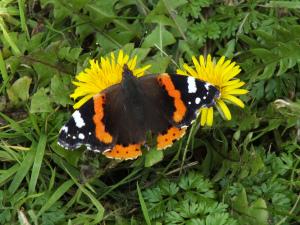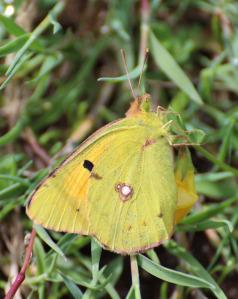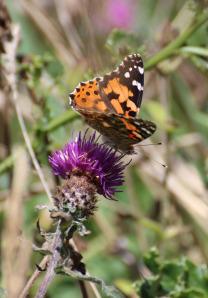When I think of autumn migrations, it’s the Whooper Swans, Fieldfares and geese that first come to mind. Or I might think of the birds that leave us in the autumn – the Swallows, Arctic Terns and warblers that have been here for the summer. The distances many of these birds fly is astounding, from the Arctic Terns crossing from one polar region to the other, to the many species that travel between northern Europe and sub-Saharan Africa.

Red Admiral (Vanessa atalanta), one of our migratory butterfly species (photo: Amanda Scott)
If these migrating birds make us marvel, then what about the even more fragile creatures that cross to our shores through the summer and autumn? I mean the butterflies and moths, of course. It’s hard to believe that these insects with their delicate wings make it here intact across the sea, buffeted by winds and yet flying strongly. And make it they do. The Monarchs of North America are perhaps the most famous migratory Lepidoptera, but they are far from alone in their traveling habit.

Buttercup-coloured Clouded Yellows (Colias croceus) are a beautiful sight through summer and into milder autumns (photo: Amanda Scott)
Here in Cornwall, we are still getting new arrivals. Some are regular migrants, like the Hummingbird Hawkmoth (Macroglossum stellatarum) or Clouded Yellow (Colias croceus) butterfly, while others are more exotic and rare, blown across on prevailing winds. We’ve even had a handful of sightings of Monarchs in Cornwall over the last few weeks, carried here across the Atlantic.
I’ve just been reading a press release from Atropos (the UK journal for butterfly, moth and dragonfly enthusiasts) about the visiting moth species sighted here around Halloween. It’s well worth a look at the Atropos website – they have a page dedicated to recording new arrivals. From their list, I can see that someone saw a Hummingbird Hawkmoth – a moth associated with the sunny days of summer – in their garden in Penzance on 2 November. It was a warm day for November, but if a moth could shiver…
![What’s been flying in? Slender-burnished Brass moth (), a rare visitor to Britain (photo: By JMK (Own work) [GFDL (http://www.gnu.org/copyleft/fdl.html) or CC-BY-SA-3.0 (http://creativecommons.org/licenses/by-sa/3.0)], via Wikimedia Commons)](http://m5.paperblog.com/i/105/1050038/whats-been-flying-in-L-u88HZw.jpeg)
Slender-burnished Brass moth (Thysanoplusia orichacea), a rare visitor to Britain (photo: By JMK (Own work) [GFDL (http://www.gnu.org/copyleft/fdl.html) or CC-BY-SA-3.0 (http://creativecommons.org/licenses/by-sa/3.0)%5D, via Wikimedia Commons)
Thysanoplusia orichaceaI also learned from the press release that Cornwall has received some less welcome moth visitors this year. The Box Tree Moth (Cydalima perspectalis) is an Asian moth, introduced to Europe over the last decade. The moth itself is rather lovely, with white, almost transparent wings. It’s the caterpillars that are the problem, with their ability to rapidly defoliate the Box shrubs (Buxus ssp.) beloved of topiary and ornamental gardens. The first British records of this moth were made five years ago, and this year there are two records in Cornwall. Oh dear.
But let’s console ourselves by remembering that, in our mild-to-date autumn weather, everyone is still reporting sightings of our regular migrant butterflies – Red Admirals (Vanessa atalanta), Clouded Yellows and Painted Ladies (Vanessa cardui). It’s already turning colder, so let’s enjoy them before we finally have to wrap up warmer for the winter.

Painted Lady (Vanessa cardui) near Kynance (photo: Amanda Scott)
If you want to find out more about butterflies and moths, and/or migrant species in particular, here are some useful websites.
Atropos, the journal for butterfly, moth and dragonfly enthusiasts. This website has information about new arrivals, how to get involved in recording and sharing information.
http://www.atropos.info/site/index.php/
Butterfly Conservation. This national charity’s website has information about butterflies and day-flying moths, how you can help, including recording, and news on their research and conservation projects.
http://butterfly-conservation.org
Cornwall Butterfly Conservation. The local branch of the national charity. If you live in Cornwall, you might like to go along to their annual AGM and members’ day on 7th March 2015, when Paul Waring, a nationally renowned moth expert, will be giving a talk. Details are on their website.
http://www.cornwall-butterfly-conservation.org.uk
UK Moths. A great website with lots of good photos to help in identification.

